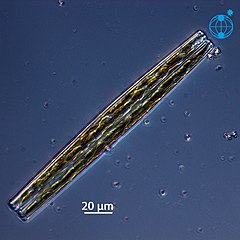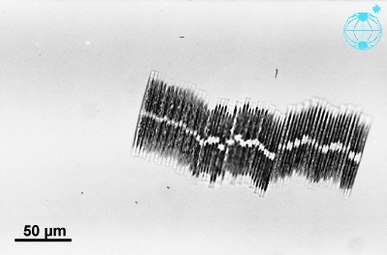| Bacillaria | |
|---|---|

| |
| Bacillaria paxillifer | |
| Scientific classification | |
| Domain: | Eukaryota |
| Clade: | Diaphoretickes |
| Clade: | SAR |
| Clade: | Stramenopiles |
| Phylum: | Gyrista |
| Subphylum: | Ochrophytina |
| Class: | Bacillariophyceae |
| Order: | Bacillariales |
| Family: | Bacillariaceae |
| Genus: | Bacillaria J.F. Gmelin (1791) |
Bacillaria is a diatom genus in the family Bacillariaceae.
| External videos | |
|---|---|
Species
- Bacillaria paradoxa Gmelin 1788
- Bacillaria paxillifer (O.F. Müller) Hendey (1951)
Lifecycle
This genus is photosynthetic, and reproduces sexually and asexually.
Description
Cells are elongated and motile, sliding along each other, in stacked colonies. Cells are rectangular in girdle view (when in colonies), and lanceolate in valve view. Raphe system is slightly keeled and runs from pole to pole. Two large plate-like chloroplasts are present, one near each end of the cell. The nucleus is located centrally. Cells are yellow-brown in colour. Fibulae are strong, and the valve surface is covered in transverse parallel structures called striae.
Space station
Three diatom species were sent to the International Space Station, together with the huge (6 mm length) diatoms of Antarctica and the exclusive colonial diatom, Bacillaria paradoxa. The cells of Bacillaria moved next to each other in partial but opposite synchrony by a microfluidics method.
Measurements
Length (apical axis): 70 - 200 μm
Width (trans-apical axis): 5 - 8 μm
Height (Pervalvar axis): 5 - 10 μm
Fibulae: 7 - 9 in 10 μm
Striae: 20 - 21 in 10 μm
Habitat
Benthic zone, marine and brackish/freshwater species, but is also commonly found in plankton.
References
- "ITIS Standard Report Page: Bacillaria". www.itis.gov. Retrieved 20 April 2018.
- M.G. Kelly; H. Bennion; E.J. Cox; B. Goldsmith; J. Jamieson; S. Juggins D.G. Mann; R.J. Telford (2005). "Common freshwater diatoms of Britain and Ireland: an interactive key". Environment Agency, Bristol. Archived from the original on 2012-04-25. Retrieved 2011-12-21.
- "Algaebase".
- Mishra, Meerambika; Arukha, Ananta P.; Bashir, Tufail; Yadav, Dhananjay; Prasad, G. B. K. S. (5 July 2017). "All New Faces of Diatoms: Potential Source of Nanomaterials and Beyond". Frontiers in Microbiology. 8. Frontiers Media SA: 1239. doi:10.3389/fmicb.2017.01239. ISSN 1664-302X. PMC 5496942. PMID 28725218.
 Material was copied from this source, which is available under a Creative Commons Attribution 4.0 International License.
Material was copied from this source, which is available under a Creative Commons Attribution 4.0 International License.
- "Apical axis | Glossary - Diatoms of North America".
- "Transapical axis | Glossary - Diatoms of North America". Archived from the original on 2017-02-05. Retrieved 2017-02-04.
- "Pervalvar axis | Glossary - Diatoms of North America". Archived from the original on 2017-02-05. Retrieved 2017-02-04.
- "EOS - Phytoplankton Encyclopedia Project". www.eoas.ubc.ca. Retrieved 2017-02-04. Phytoplankton Encyclopedia Project
| Taxon identifiers | |
|---|---|
| Bacillaria | |
